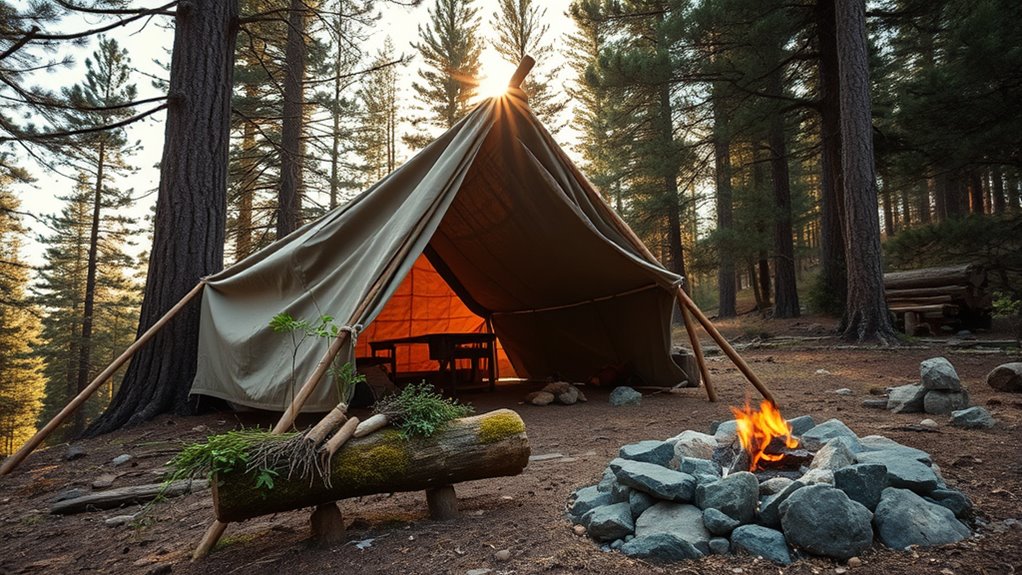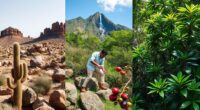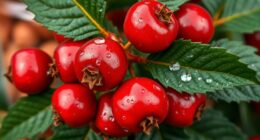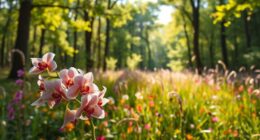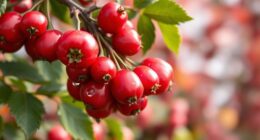To establish a long-term foraging camp, select a location with abundant sunlight, nearby water sources, and diverse terrain like forests and meadows. Build durable, camouflaged shelters with waterproof materials, and set up efficient water collection with purification methods like boiling or filtration. Practice sustainable foraging, preserve food through dehydration or fermentation, and create secure storage to protect supplies. Fostering community roles and maintaining hygiene guarantees your camp thrives—keep exploring for detailed steps to sustain this lifestyle.
Key Takeaways
- Select a location with abundant sunlight, water sources, diverse terrain, and sustainable plant life for long-term foraging success.
- Design durable, weatherproof shelters using natural or synthetic materials, considering insulation and camouflage for safety.
- Set up water collection and purification systems using nearby water sources, rainwater harvesting, and safe filtration methods.
- Practice responsible foraging by harvesting invasive species, avoiding overharvesting, and preserving ecological balance through sustainable methods.
- Establish secure, organized food storage, waste management, and community roles to maintain hygiene, safety, and social cohesion.
Selecting the Ideal Location for Your Foraging Base
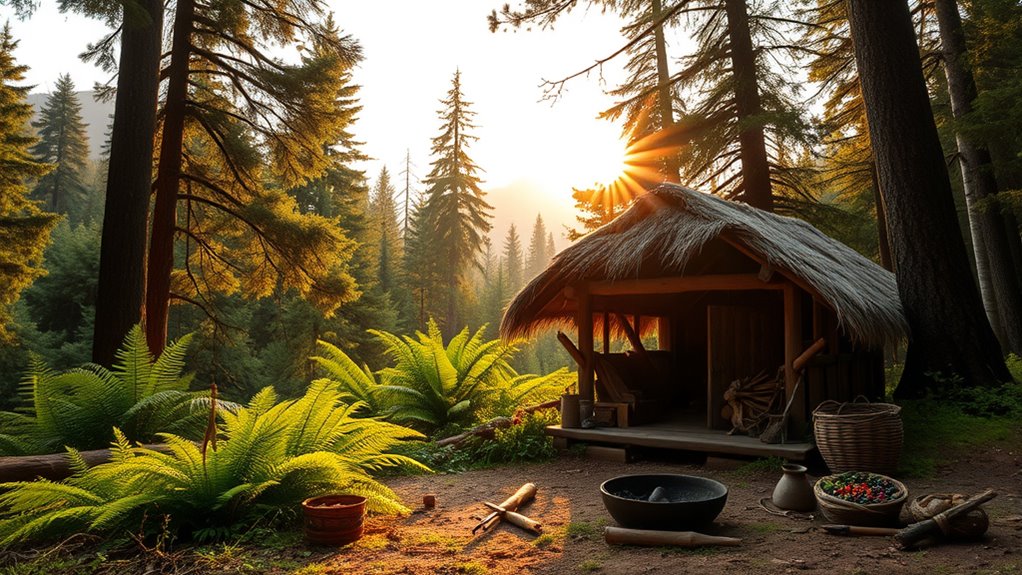
Choosing the right location for your foraging camp is crucial to guarantee a reliable and sustainable food source. Look for areas with abundant sunlight, such as clearings, especially in humid regions, to promote plant growth. Additionally, selecting sites with diverse plant life can significantly enhance the variety of edible plants you can harvest. Proximity to water sources like streams or ponds increases biodiversity and provides access to edible aquatic plants. Assess soil quality; diverse soils support a wider variety of plants. Incorporating habitat diversity in your site selection can further enhance the variety and abundance of edible plants available. Incorporating soil health practices can improve plant growth and sustainability over time. Aim for terrain variety—forests, meadows, and clearings—since different environments offer unique foraging options. Elevation also matters, as higher areas may host different plant species than lower ones. Additionally, consider transition zones like forest-meadow edges or recently disturbed areas, which often have rich, diverse plant life. A strategic, well-chosen spot ensures a plentiful, sustainable foraging supply over time. Selecting sites with adequate sunlight exposure can also boost plant productivity and growth. Proper plant diversity in your chosen location further enhances the sustainability of your foraging efforts.
Designing Essential Shelter Structures for Long-Term Stay
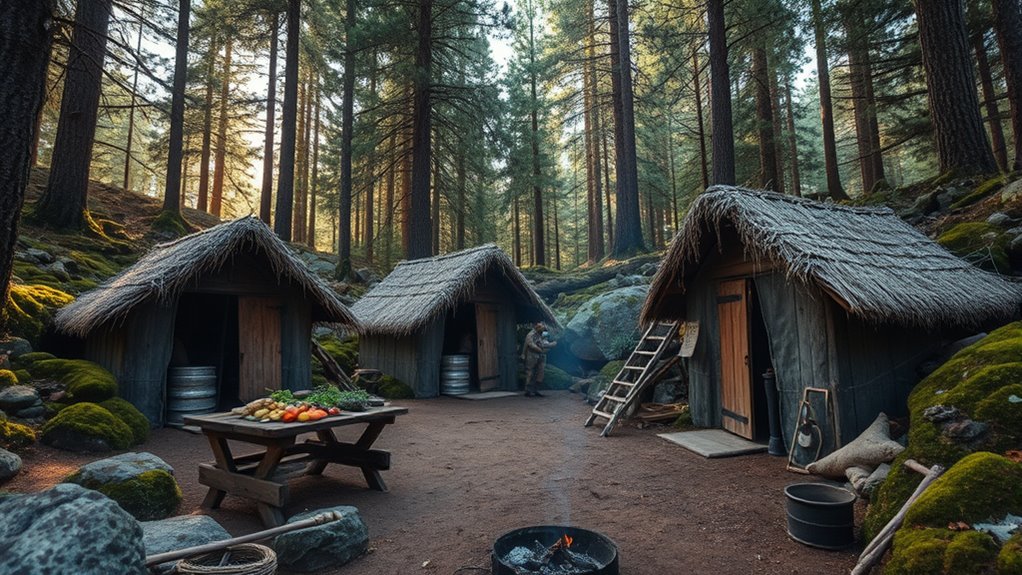
Designing essential shelter structures for a long-term stay requires careful consideration of both environmental challenges and your needs for safety and comfort. You must choose waterproof and windproof materials to withstand rain and wind, ensuring durability over time. Using low light office plants in shelter design can improve air quality and create a more calming environment. Adequate space inside your shelter enhances livability and boosts morale. Prioritize structural integrity with sturdy frameworks, using natural or synthetic materials like wood, tarps, and ropes. Camouflage may be necessary to avoid detection, so incorporate natural debris or concealment techniques. Modular designs allow easy expansion or modifications as your needs evolve. Regular maintenance, weatherproofing, and replacing worn materials keep your shelter reliable. Incorporating insulation and proper ventilation helps adapt to climate conditions, maintaining a safe and comfortable environment for long-term survival. Additionally, understanding retirement planning concepts such as risk mitigation can inform how you prepare your shelter for unforeseen challenges. Ensuring proper resource management is essential for sustainability during extended periods of use. Implementing water conservation strategies can help extend your water supply and maintain hydration levels. Planning for emergency supplies ensures you are prepared for unexpected events that may impact your shelter’s stability and safety.
Setting Up Efficient Water Collection and Purification Systems

To guarantee a reliable water supply in survival situations, you need to identify and utilize various collection methods suited to your environment. If you’re near rivers, lakes, streams, or springs, these sources provide direct access, but always purify water before use.
Collect rainwater from surfaces into containers for later drinking, or melt snow and ice during colder months. Use mesh or cloth to gather water from fog, or place a plastic bag around a leafy branch to collect transpired moisture. Employing water harvesting techniques can increase your water collection efficiency in arid regions. Additionally, understanding water quality assessment can help you determine the safety of your collected water.
Collect rain, melt snow, or harvest moisture with simple DIY methods for reliable water sources.
For purification, boiling water kills bacteria, viruses, and parasites quickly. Solar distillation uses sunlight to produce clean water, while filtering through pebbles, sand, and charcoal removes debris. Understanding water purification techniques can help you select the most effective method for your situation. Incorporating chemical treatment methods, such as iodine or chlorine tablets, can further ensure water safety when other methods are unavailable.
Chemical tablets or portable tools like LifeStraw ensure safe drinking water, maximizing efficiency for long-term survival. Understanding market dynamics and consumer behavior, as well as leveraging innovative solutions in water purification techniques, can greatly improve your chances of establishing a sustainable water supply.
Developing Sustainable Foraging and Food Preservation Techniques
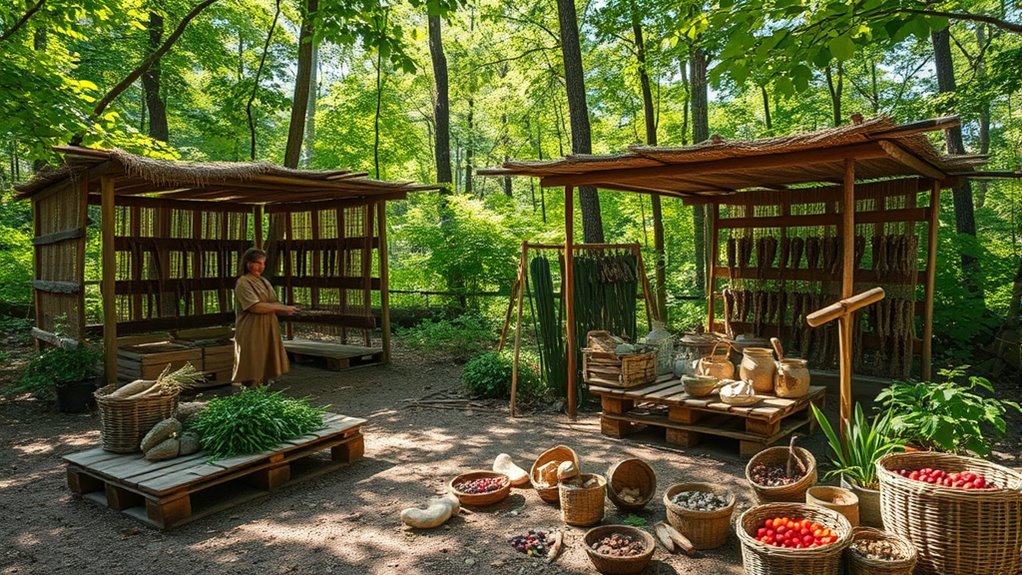
Building a sustainable food supply begins with responsible foraging practices that safeguard the environment while providing nourishment. Focus on harvesting invasive species to reduce competition with native plants, helping restore ecological balance. Use fractional harvesting—taking only a small portion of each plant—to ensure continued growth and reproduction. Incorporating advanced fraud detection techniques can further ensure the integrity of your foraging operations by preventing theft or misrepresentation. Protect sensitive species like trillium by avoiding them during harvest. Return seeds, such as from stinging nettle, to promote future growth. When collecting medicinal plants, do so without depleting their populations. Respect species diversity and seasonal cycles by adjusting your harvesting times. Avoid disturbing habitats with rare or endangered species, and monitor for plant diseases. Implement food preservation methods like dehydration, fermentation, and pickling to extend your harvest’s lifespan and maintain nutritional value. Additionally, understanding sustainable harvesting methods helps ensure that foraging remains a viable and environmentally friendly practice over the long term. Employing community engagement can foster local support and shared responsibility for conservation efforts. Incorporating secure transaction systems and merchant services can also help manage the distribution and sale of your foraged products efficiently and safely. Maintaining proper storage containers is essential for keeping preserved foods fresh and preventing contamination.
Building Safe and Secure Food Storage Solutions

Creating safe and secure food storage solutions is essential for maintaining a reliable food supply, especially in remote or self-sufficient settings. Use freeze-dried foods, which have a long shelf life and retain nutrients. Protect wooden containers from pests and moisture, or opt for food-safe plastics and durable metal containers with coatings to prevent rust. Bury sealed containers underground to shield food from heat and light. Reinforced doors, walls, and camouflage help keep storage safe from intruders, animals, and detection. Choose cool, dry, and inaccessible locations like basements or away from heat sources for ideal storage. Implement strategies like FIFO, regular inventory checks, and stock rotation to keep food fresh. Proper organization and security measures ensure your food remains safe, accessible, and protected over the long term. Additionally, understanding Affairs – Cheating Husband Secrets can inform how to safeguard your privacy and security in sensitive situations, emphasizing the importance of discretion and protective measures. Recognizing the importance of long-term sustainability can further enhance your storage strategies by ensuring your food supply remains resilient over time. Incorporating knowledge of marine conservation practices can also help maintain healthy ecosystems, ensuring a sustainable source of wild foods for the future. Employing pest control methods is crucial to prevent infestations that could compromise stored supplies.
Establishing Hygiene and Waste Management Practices

Establishing effective hygiene and waste management practices is essential for maintaining health and safety in any self-sufficient setting. You are trained on data up to October 2023. Keeping food preparation in designated areas away from living spaces is important to reduce wildlife attraction. Wash dishes with minimal, unscented soap in a designated area, and disperse rinse water safely. Store trash in animal-proof containers and dispose of waste by burying it at least 200 feet from water sources or packing it out. Organic waste can be composted carefully to avoid pests and proper waste disposal can also help maintain the integrity of electric dirt bikes and other essential equipment. Always minimize litter, leave the environment cleaner, and construct latrines away from water and living zones to prevent contamination. Additionally, understanding dog names can help foster a positive environment if dogs are part of your camp, contributing to safety and companionship. Recognizing the importance of hygiene practices helps prevent illness and promotes overall well-being in your camp community.
Fostering Community Roles and Maintaining Group Cohesion
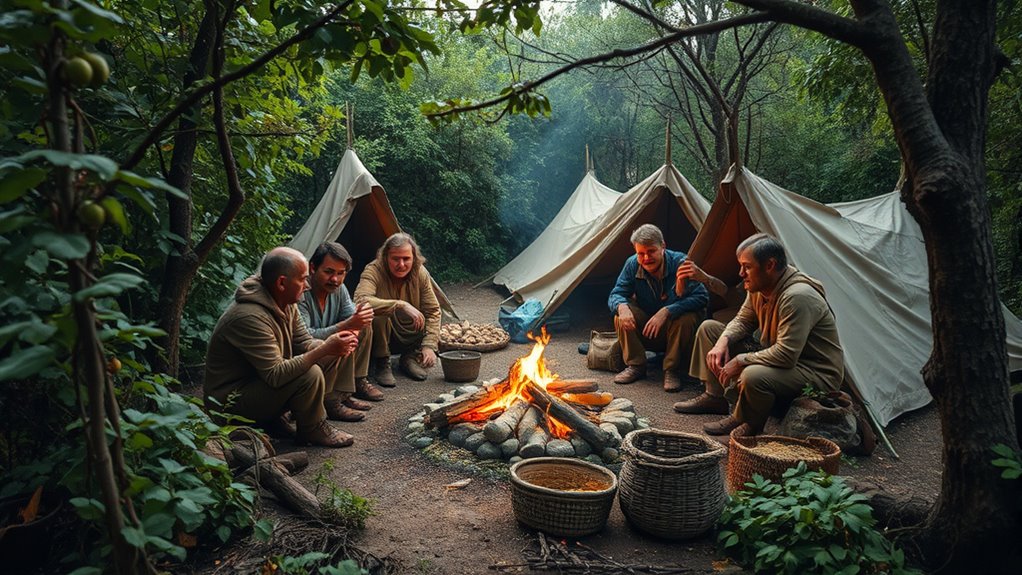
Effective group cohesion in a foraging community depends on clear roles, mutual respect, and active participation. You’ll find that an egalitarian social structure encourages sharing responsibilities and resources, strengthening bonds.
Respect for elders, especially those with healing or ritual knowledge, reinforces cultural continuity. Engaging community members in activities like medicine walks or traditional food tastings boosts camaraderie.
Offering diverse skill-sharing workshops in foraging and ecosystem management increases understanding and involvement. Including everyone, regardless of gender, and involving youth through community events fosters inclusivity.
Recognizing contributions publicly and encouraging mentorship nurtures social bonds. Open communication, shared decision-making, and respectful mediation resolve conflicts swiftly.
Frequently Asked Questions
How Do I Identify Truly Sustainable Wild Food Sources?
To identify truly sustainable wild food sources, you need to observe plant abundance and harvest responsibly, avoiding overharvesting.
Consult local experts and keep detailed records of your finds for accurate identification.
Be aware of seasonal cycles and environmental factors like pollution and biodiversity.
Practice minimal impact harvesting, use proper tools, and involve the community.
These steps help guarantee your foraging supports ecological balance and preserves resources for the future.
What Are the Best Methods for Protecting Food From Wildlife?
You might think wildlife is harmless until your food becomes their buffet. To protect your stash, use bear canisters or bear-resistant containers—they’re tough enough to deter even the hungriest critters.
Hang food bags high in sturdy trees, at least 15 feet up and away from trunks. Keep your campsite spotless, avoid strong-smelling foods, and store trash securely.
These simple steps turn your campsite into a wildlife-proof fortress—no more unwanted guests!
How Can I Prevent Contamination of Water Sources Naturally?
To prevent water source contamination naturally, start by maintaining buffer zones of grass or plants around the water. Avoid using chemicals, fertilizers, and pesticides near these sources. Properly dispose of waste and hazardous materials away from water.
Use natural barriers like rocks or vegetation to prevent runoff. Protect wetlands and soil layers that naturally filter water.
Community efforts like cleanup events and water education also help keep water clean.
What Are Effective Ways to Teach Community Members Foraging Skills?
You can teach community members foraging skills effectively by organizing hands-on trips where they learn plant identification and harvesting techniques. Use detailed guides, mobile apps, and expert workshops for support.
Encourage interactive activities like games and recipe sharing to make learning engaging. Pair experienced foragers with newcomers for mentorship, and create community forums for ongoing discussion.
This approach builds confidence, knowledge, and sustainable foraging habits among participants.
How Do I Balance Resource Harvesting With Conservation Ethics?
You need to balance resource harvesting with conservation ethics by harvesting strategically, only taking what you need, and leaving enough for wildlife and future growth.
Always monitor plant health, avoid over-harvesting, and rotate foraging areas.
Use appropriate tools to minimize damage, respect legal regulations, and acknowledge indigenous rights.
Conclusion
Just like Robinson Crusoe adapted to survive on his island, your success depends on planning and resilience. By carefully choosing your location, building secure shelter, and managing resources wisely, you create a haven amid challenges. Remember, even in the wilderness, unity and ingenuity are your greatest tools—turning your foraging camp into a sustainable sanctuary. With patience and perseverance, you’ll master the art of long-term survival, forging your own story of resilience and self-reliance.

